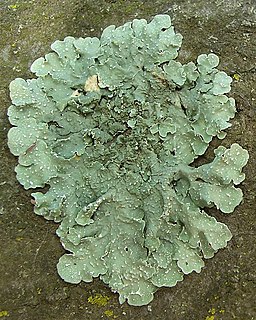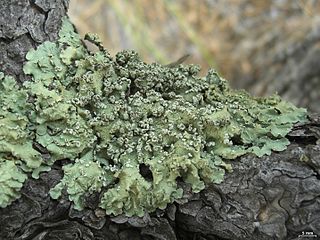
Hypogymnia is a genus of foliose lichens in the family Parmeliaceae. They are commonly known as tube lichens, bone lichens, or pillow lichens. Most species lack rhizines that are otherwise common in members of the Parmeliaceae, and have swollen lobes that are usually hollow. The lichens usually grow on the bark and wood of coniferous trees.

Punctelia is a genus of foliose lichens belonging to the large family Parmeliaceae. The genus, which contains about 50 species, was segregated from genus Parmelia in 1982. Characteristics that define Punctelia include the presence of hook-like to thread-like conidia, simple rhizines, and point-like pseudocyphellae. It is this last feature that is alluded to in the vernacular names speckled shield lichens or speckleback lichens.
Parmotrema aldabrense is a species of lichen in the family Parmeliaceae that is found in Africa. It was first described by Carroll William Dodge in 1959 as a species of Parmelia. Mason Hale transferred it to the genus Parmotrema in 1974. The type collection was made in the Aldabra Islands, where it was found growing on tamarind. It has also been recorded from Madagascar. The lichen has an olive-buff coloured thallus measuring up to 14 cm (5.5 in) in diameter.
Parmotrema amaniense is a species of corticolous lichen in the family Parmeliaceae. Found in Africa, the lichen was originally described by J. Steiner and A. Zahlbruckner as a species of Parmelia in 1926. The holotype collection was made in Usambara (Tanzania) at an elevation of 800 metres (2,600 ft). Krog & Swinscow transferred the taxon to Parmotrema in 1983. Secondary chemicals present in Parmotrema amaniense include alectoronic acid, protocetraric acid, and atranorin. In addition to Tanzania, it has been recorded in Uganda, Angola, Malawi, Mozambique, Sierra Leone, Zambia, and Zimbabwe.

Punctelia subrudecta is a species of lichen in the family Parmeliaceae. It was described as a new species by Finnish lichenologist William Nylander as Parmelia subrudecta. Hildur Krog transferred it to the genus Punctelia in 1982.

Punctelia reddenda is a widely distributed species of foliose lichen in the family Parmeliaceae. It occurs in Africa, Europe, North America, and South America, where it grows on bark and on rock.
Punctelia riograndensis is a species of foliose lichen in the family Parmeliaceae. Found in Africa and South America, it was formally described as a new species by Norwegian lichenologist Bernt Lynge in 1914, as Parmelia riograndensis. The type specimen was collected in 1892 from Porto Alegre Municipality in Rio Grande do Sul State (Brazil) by Swedish lichenologist Gustav Malme. In 1982, Hildur Krog circumscribed the genus Punctelia to contain Parmelia species with rounded pseudocyphellae, and P. riograndensis was one of the 22 species that she transferred to the new genus.

Punctelia punctilla is a species of foliose lichen in the family Parmeliaceae. It is found in Africa, South America, and North America, where it grows on bark and on rocks. The main characteristics that distinguish Punctelia punctilla from other species of Punctelia are the presence of isidia on the thallus surface, a pale brown thallus undersurface, and the presence of lecanoric acid in the medulla.

Punctelia hypoleucites, commonly known as the southwestern speckled shield lichen, is a species of foliose (leafy) lichen in the family Parmeliaceae. First formally described by Finnish botanist William Nylander as a species of Parmelia, it was transferred to the genus Punctelia in 1982. The lichen is found in Africa, North America, and South America, where it grows on the bark of both hardwood and coniferous trees. Its greenish-grey thallus is covered with tiny white pseudocyphellae – minute holes in the thallus surface that facilitate gas exchange. Some macroscopic features that help distinguish this species from other related members of the genus include the presence and the structure of the apothecia, the absence of asexual surface propagules, and the light brown color of the thallus undersurface. Chemically, the presence of lecanoric acid in the medulla and atranorin in the cortex help distinguish it from lookalikes.

Flavopunctelia flaventior is a species of foliose lichen in the family Parmeliaceae. It was first formally described as a new species by James Stirton in 1877 as Parmelia flaventior. In 1982, Hildur Krog transferred it to the subgenus Flavopunctelia of her newly circumscribed genus Punctelia, created to contain Parmelia species with punctate (point-like) pseudocyphellae. Mason Hale raised this subgenus to generic status a couple of years later, setting Flavopunctelia flaventior as the type species of the new genus. The lichen is commonly known as the speckled greenshield. Flavopunctelia flaventior occurs in Asia, Europe, East Africa, North America, and South America.
Flavopunctelia darrowii is a species of foliose lichen in the family Parmeliaceae. It was first formally described as a new species by John Walter Thomson in 1950 as Parmelia darrowi. It is named after American botanist Robert Arthur Darrow. In 1982, Hildur Krog transferred it to the subgenus Flavopunctelia of her newly circumscribed genus Punctelia, created to contain Parmelia species with punctate (point-like) pseudocyphellae. Mason Hale raised this subgenus to generic status a couple of years later.
Flavopunctelia praesignis is a species of foliose lichen in the family Parmeliaceae. It was first described as Parmelia praesignis by Finnish botanist William Nylander in 1872. In 1982, Hildur Krog transferred it to the subgenus Flavopunctelia of her newly circumscribed genus Punctelia, created to contain Parmelia species with punctate (point-like) pseudocyphellae. Mason Hale raised this subgenus to generic status a couple of years later. The lichen is colloquially known as the fruiting speckled greenshield. It is found in the southern United States, in various states of Mexico, and in South America. It has also been reported from Kenya, but that may be due to misidentification.

Flavopunctelia soredica is a species of foliose lichen in the family Parmeliaceae. It was first described as Parmelia soredica by Finnish botanist William Nylander in 1872. In 1982, Hildur Krog transferred it to the subgenus Flavopunctelia of her newly circumscribed genus Punctelia, created to contain Parmelia species with punctate (point-like) pseudocyphellae. Mason Hale raised this subgenus to generic status a couple of years later. The lichen is colloquially known as the powder-edged speckled greenshield. It is widely distributed, having been recorded from North America, South America, South Africa, India, Russia, China and Japan.
Punctelia borrerina is a species of foliose lichen in the family Parmeliaceae. It is found in Mexico and South America.

Punctelia graminicola is a species of foliose (leafy) lichen in the family Parmeliaceae. It grows on rocks, and, less frequently, on bark in North America, South America, and East Africa. It has a blue-grey thallus measuring up to about 15 cm (6 in), covered with tiny pores called pseudocyphellae. Sometimes the lichen forms small lobes that project out from the surface. Fruiting bodies are uncommon in this species; if present, they resemble small cups with a brown internal disc measuring 3–10 mm (0.1–0.4 in) in diameter. A lookalike species, Punctelia hypoleucites, is not readily distinguishable from Punctelia graminicola by appearance or habitat alone; these species can only be reliably differentiated by examining the length of their conidia.
Punctelia neutralis is a species of foliose lichen in the family Parmeliaceae. It was first formally described in 1971 by American lichenologist Mason Hale, as Parmelia neutralis. The type specimen was collected by Dutch mycologist Rudolf Arnold Maas Geesteranus from the Diepwalle Forest Reserve in Cape Province, South Africa. Hildur Krog transferred it to the Punctelia in 1982, when she promoted that taxon to generic status. In addition to several countries in Africa, the lichen has also been reported from India and from Taiwan.

Punctelia stictica is a species of foliose lichen in the family Parmeliaceae. It is widely distributed lichen, recorded in Africa, Europe, North America, South America, and Greenland. It is typically found growing on rocks.
Punctelia canaliculata is a species of foliose lichen in the family Parmeliaceae. It is found in South America.

Punctelia borreri is a species of foliose lichen in the family Parmeliaceae. It is a common and widely distributed species, occurring in tropical, subtropical, and temperate regions of Africa, Asia, Europe, North America, Oceania, and South America. The lichen typically grows on bark of deciduous trees, and less commonly on rock. Some European countries have reported increases in the geographic range or regional frequency of the lichen in recent decades, attributed alternatively to a reduction of atmospheric sulphur dioxide levels or an increase in temperatures resulting from climate change.









